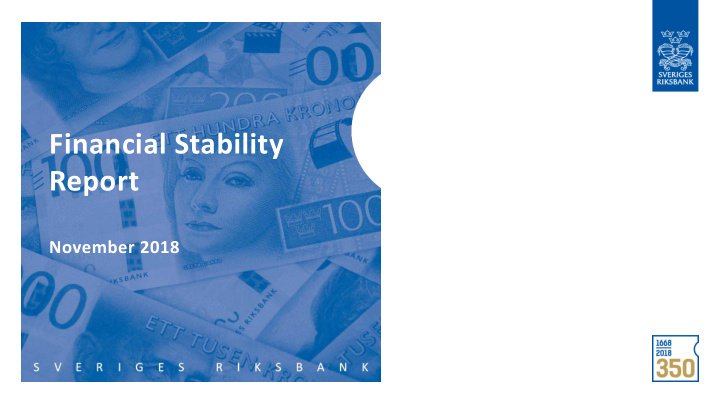



Financial Stability Report November 2018
Risks linked to global developments Trade conflicts Brexit Emerging market economies European banking sector Public finances in Europe
Household indebtedness – the greatest risk Household debt ratio, percentage of annual disposable income. Total debts as a Sources: Statistics Sweden and the Riksbank share of households’ disposable incomes, totalled over the past 4 quarters.
High indebtedness making households sensitive Household interest expenses as a percentage of annual disposable income, per cent. The rhombuses show an interval for interest expenditure that is Sources: Statistics Sweden calculated on the current debt-to-income ratio, a long-term interval for the repo rate of 2.5–4 per cent and an assumption of a 2 percentage points margin and the Riksbank between the repo rate and the interest rate faced by households. The broken line shows the Riksbank’s forecast. Interest expenses are adjusted for tax relief.
Rate of price increase on housing slowing down Housing prices in Sweden, index 2005 = 100. Housing prices are seasonally-adjusted. Sources: Valueguard and the Riksbank
Still substantial need of new housing, but reduced housing investment going forward New housing starts, number. The broken columns show the Riksbank’s forecast. Sources: Statistics Sweden and the Riksbank
A combination of measures to reduce the risks inherent in household indebtedness • Structural measures on the housing market • Tax rules need to be revised • Thorough credit assessment for mortgages • Appropriate macroprudential policy
Concentrated and interlinked banking system Large The banking system is still large after Nordea’s relocation Concentrated Major banks responsible for 75 per cent of lending in Sweden Interconnected Major banks have exposures to one another Major banks refers to the four largest banks in the Swedish market: Handelsbanken, Nordea, SEB and Swedbank.
The banks are exposed to the housing and property sectors Source: Statistics Sweden The major banks’ total lending to Swedish non-financial corporations and households, percentage of loans against collateral in property.
Banks need to strengthen their resilience Source: European Banking Authority (EBA) Leverage ratios in different countries, per cent, June 2018. Refers to weighted average per country.
The banks need to manage their liquidity risks themselves Source: The Riksbank The four major banks’ daily LCR in SEK, single lowest observation per month, per cent.
Vulnerable financial system exposed to risks Reduce risks linked to household indebtedness Strengthen banks’ resilience
Recommend
More recommend